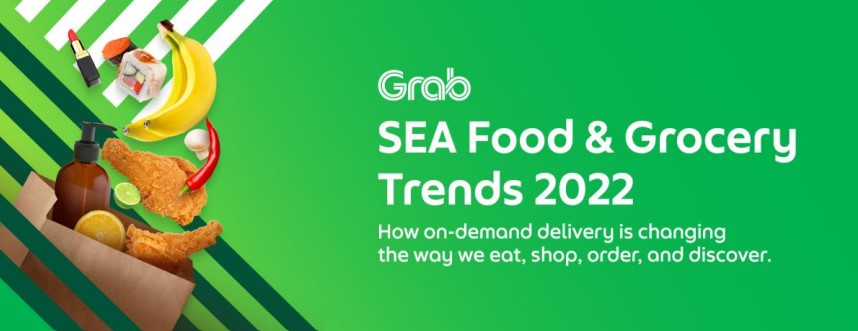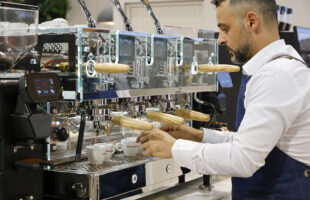
Courtesy of Grab
- 7 in 10 consumers view delivery as a permanent part of their post-pandemic life, and 8 in 10 merchants say delivery is a must-have for their businesses
- More consumers are using delivery apps to discover new merchants
- New and enhanced Grab features enable consumers to discover and save more
Singapore, November 24, 2022 – Seven in 10 consumers view delivery as a permanent part of their post-pandemic life, and eight in 10 merchants say delivery is a must-have for their businesses, revealed Grab’s latest Southeast Asia (SEA) Food and Grocery Trends 2022 report.
Grab also unveiled new and enhanced features to capture evolving delivery trends along with the report. These include a revamped rating and reviews experience, a new self-pick-up toggle, and a saver delivery option to bring more convenience to consumers and help them save more.
The report, which combined survey insights from over 60,000 food and grocery delivery users in SEA and data insights from Grab’s platform, revealed that the “delivery life” is here to stay. Results also showed an increasing dependence on delivery apps among consumers who now rely on platforms as their “search engine” to discover and try merchants they have never visited in person.
Sean Goh, Regional Head of Mobility and Deliveries, commented on the findings: “Deliveries continue to be a prominent part of consumers’ lives. In fact, consumers are shifting more and more of their food journey online, which presents additional opportunities for brands to reach and engage consumers online. This has inspired us to rethink our app experience to make food discovery more intuitive so that we drive more demand back to our merchant partners.”
Key industry trends from the report are:
- Consumers regard food and grocery delivery services as a new way of life, instead of a necessity during Covid, and an indulgence before that: seven in 10 consumers said that deliveries had become a permanent part of their life today. Among active users surveyed, the top three reasons for using these services were 1) convenience, 2) the ability to access what they want on demand, and 3) preparation for social gatherings.
- With deliveries becoming a permanent lifestyle, consumers are ordering more and spending more per order: Monthly food and grocery delivery expenditures were 30 percent higher in May 2022 compared to November 2021. Singapore consumers spent most on deliveries, while Vietnamese consumers ordered most frequently in the region. Overall, the top 25 percent most heavy users contributed close to three-quarters (71%) of the region’s delivery spending. GrabFood was their most often used brand across Southeast Asia for food delivery.
- Delivery users are shifting their food journeys online: More than 90 percent of consumers pre-purchased food vouchers and read food reviews online; more than 80 percent made dining reservations or ordered self-pick-up online, and more than 70 percent ordered and paid for their dine-in meals online. Overall, 9 in 10 consumers said they prefer brands with an integrated online-to-offline experience.
- Consumers are using delivery apps as their food search engine: Consumers are discovering new merchants through delivery apps. Eighty-eight percent of consumers got to know a new store because of delivery apps; 74 percent browsed delivery apps without having any restaurant or store in mind. On average, GrabFood users spent 17 minutes deciding what to order.
- Merchants continue to digitalise to embrace the “delivery life”: eight in 10 merchants said that delivery platforms are a must-have for their business. Merchants, on average, saw a 15 percent increase in total sales revenue compared to before joining delivery platforms.For McDonald’s, around 30 percent of their Asia sales now come from deliveries, up from 10 percent before Covid. The report also unpacked consumers’ food and grocery ordering habits:
- Healthy and plant-based alternatives are going mainstream: About one in two surveyed Southeast Asian consumers tried plant-based options in the last 6 months. Eighty-six percent of consumers ate at least one healthy meal every two to three days. This trend was consistent with Grab users’ ordering behaviours, with demand for healthy meals tripling on GrabFood between 2019 and 2022 and “health and wellness” orders growing 5x on GrabMart between 2020 and 2022.
- Entertaining from home is still a thing post-lockdowns: two in five consumers said they prefer ordering in for social gatherings instead of eating out. This explains why large-sized weekend orders to residential areas doubled on GrabFood over the past two years. Consumers in the Philippines were the most hospitable, with such orders surging by 500 percent in the same period. Across all countries, consumers mostly went for combo meals, sharing platters, and finger foods.
- Snacking is no longer a solo but a group activity: With workplaces reopening, over 60 percent of consumers said they tend to order snacks for more than one person each time. Consumers in Thailand and the Philippines were the biggest snackers, snacking at least 4x a week compared to the 3x regional average.
- Southeast Asians’ love for fried chicken remains unchanged, but the same cannot be said for bubble tea: Fried chicken once again made the top 5 most-ordered GrabFood item list in all countries except Singapore. Bubble tea, a former Southeast Asia favourite, fell off the top five charts this year.
- Local food still hits the spot like no other: From prata to papaya salad, nasi goreng, and banh mi, local food continues to be a top trending order in all markets except the Philippines.
Three Enhanced Features on Grab In light of these new trends, Grab is launching new and enhanced features and initiatives to improve merchant discovery and deepen consumer engagement with the app:
- A revamped ratings and reviews feature: With 94 percent of consumers turning to online reviews to make dining decisions, Grab has enhanced its in-app ratings and reviews experience to make it more seamless and engaging for consumers. Consumers can now view merchant ratings and read food reviews from fellow Grab users within the Grab app. They can also easily order the same dishes from reviews with just one click of the “order now” button. Merchants can now also reply to reviews should they want to show their appreciation or provide a resolution.
- A brand new self-pick-up toggle: 83 percent of consumers now use online takeaway services. Grab’s soon-to-come self-pick-up toggle feature will give self-pick-up merchants greater in-app visibility. Consumers can switch from delivery to self-pick in a single tap and see all available merchants around them.
- More ways to save for a guilt-free delivery lifestyle: Grab’s new “Saver” delivery option lets consumers save on delivery fees in exchange for a slightly longer wait time. This feature was specially created to provide more affordable delivery options for consumers. Consumers can also subscribe to GrabUnlimited subscription packs that come with delivery discount vouchers across various Grab services. Today, one in three food delivery users is on a subscription plan, and they tend to order 44 percent more frequently and spend close to 18 percent more than non-subscribers.
“We hope to help more businesses succeed online. For businesses that are already online, our teams will work closely with them to apply these insights to enable them to build a stronger online presence,” added Goh.
Grab is committed to supporting merchants and brands to grow through its platform. Its GrabMerchant super app comes with various self-serve tools to help merchants optimise their menus, leverage insights to sharpen their sales and marketing strategies, and create effective advertising campaigns to stand out from the rest. Grab’s Advertising unit, GrabAds, also supports brands outside its ecosystem to reach and engage their target audience. On average, GrabAds deliver a 3x to 6x return on advertising spending per dollar.








